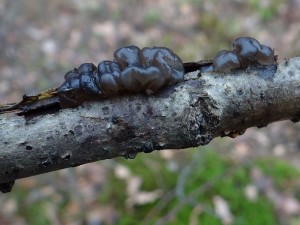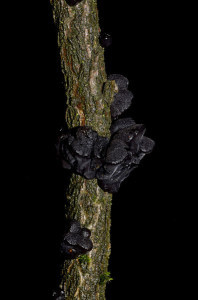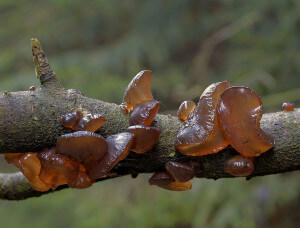
The name Jelly Roll (Exidia recisa, glandulosa, nigricans) conjures up images of home made pastries with jelly and sugar, but once you see a picture of this fungus you’ll see the humor in the name. A very unsightly fungus to say the least, but Amber, Black, or Brown Jelly Roll is in the group of fungus called jelly fungus or cup fungus, another common name for these species is witch’s butter. A very common fungus, they have a gelatinous texture, but the vast majority of them are edible, some are prized in certain parts of the world. This species is found growing on recently dead hardwoods.
Edibility and Culinary Use
It is rather tasteless with a gelatinous texture, but absorbs easily flavors it is cooked with. You can eat them raw or cooked. They are used to in salads and soups. They are also very commonly seen and make for a good snack when you’re in the mood for something a little different.
Health Benefits

Studies on nutrition and health benefits of this particular fungus are rare but fungus of the same Family are know to have many health benefits including reducing blood pressure and cholesterol levels. Similar species also have huge amounts of proteins, fats, polysaccharides and Iron, so eating them regularly could prevent diseases related to iron deficiency such as anemia. This species probably also contains Pectin, Calcium, Vitamin D, B1, and B2.
Cautions
This species is sometimes is said to be inedible, but that probably only refers to the fact that this particular species is not commonly eaten.
Conclusion
This is one of those foods that are often overlooked because most people would agree, it looks gross. But Jelly Roll Fungus should be consumed much more than it is now because of its health benefits. It is easy to identify and harvest, and it works well when cooked or raw.

Many of our readers find that subscribing to Eat The Planet is the best way to make sure they don't miss any of our valuable information about wild edibles.
See our privacy policy for more information about ads on this site







14 Responses
I posted this in a local foraging group and thought I’d share. Great article!
After seeing comments from the veteran foragers here, it was with great hesitation that I cooked up those black jellies (along with some wood ears) I’d gathered from my fallen oak branches, thinking they’d taste BAD. I did a bit of research, and decided on an Asian soup. I’m so glad I did! They are fantastic, the trick being to sauté in olive oil with very flavorful ingdts (chopped ginger, turmeric, garlic; sliced celery and julienned carrots) then salt it down and let the jellies absorb the flavors for about 10 more minutes before adding broth. Top with chopped green onion and cilantro. YUM!!! I’d have added rice, ditched the broth, and eaten it as fried rice if I’d had cooked rice. Next time!!
the soup sounds like a great idea, i usually end up just eating them off the branches when i see it. its hard to find big ones, they are all pretty small, especially when its been dry.
Thanks for sharing this. I literally have these EVERYWHERE on my property. Learn Your Land recently posted a YouTube video about them and it got the wheels turning, but I wanted to see if anyone else was eating them. I’m always looking for wild edibles.
Do you mind sending me a link to that video, it sounds interesting
https://www.youtube.com/watch?v=venkcVGX36Y
Just found some today.
I just found them for the first time today..Now that I know what they are and where they are, another hike is in my immediate future. Can not wait to try them.
We found a bunch of the off white jelly fungus.. Ductifera pululahuana or pale jelly roll… I’m wondering if these are edible as well. We love the others.
Good Question, I quickly looked into it and couldn’t find any information on the edibility of that species. Post here if you end up finding out.
Found masses of these today, about head high on a large broken limb (dead)….cooked some up. and down the hatch. Neither good nor bad. Felt very sleepy a little while later, may have some sedative effects? I know it lowers blood pressure however mine is already low, so maybe I overindulged into drowsiness. lol
I agree, neither good nor bad. Its just good to know they are edible. There aren’t really substantial either. more like just something to nibble on.
Sautéed some today with a little butter and garlic salt. Not bad. Sautéed until they just started to pop. They had a texture of oysters, so my wife couldn’t stomach them. I’m anxious to see if there are any positive results in regards to my blood pressure.
I have a new ‘batch’ of these to cook in some way. Past ways have included sprinkling in soup as it cooks and roasting in oven with salt til dehydrated. The roasted ones were eaten like a snack, but would work as a crunchy topping on salad or rice/quinoa bowl. When they are roasted/dehydrated, they shrink to about an eighth of their original size! Keep that in mind while choosing way to prepare them.
We recently moved from the city to a more rural area. We discovered this slimy black stuff all over our driveway. My son started calling it driveway herpes because no matter what kind of weed killer we have used it still comes back. Burning with gasoline and a torch seemed to get rid of it but after the next rain, you guessed it, it came back! So, I am trying to find a use for it. Much of my research says it can be used medicinally but I have yet to find a way to process it. Any advice would be appreciated.
I think the driveway or ground stuff is called Angel Snot. Definitely check out Learn Your Land for that. He did a fantastic video on it.